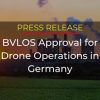With a first of its kind BVLOS waiver, the FAA allowed Verizon Skyward to inspect critical communications infrastructure with Percepto drones during a recent wildfire in Washington state
Along with numerous other fires during this deadly fire season in the Pacific Northwest, the Big Hollow Fire in Washington state burned more than 24,000 acres, resulted in mandatory evacuation orders (which were just recently lifted), and still remains only 15% contained as of this writing.
Right in the middle of the area affected by this fire, in a place so choked with smoke that it was deemed inaccessible to humans, our customer Verizon needed to inspect critical communications infrastructure. Concerned that fire, heat, water or smoke damage could potentially interrupt critical rescue and firefighting communications, the company needed to urgently assess the integrity of its equipment and facility.
The FAA Steps Up
To access the remote facility with one of its Percepto autonomous drones, Verizon’s drone subsidiary, Skyward, needed a special “beyond visual line of sight” (BVLOS) waiver from the FAA – allowing them to operate their Percepto Sparrow without an onsite pilot or on-ground visual observer.
The process of obtaining a BVLOS waiver is usually lengthy, and resulting waivers have always required a visual observer on site. Yet given the crisis, the company applied urgently to the FAA. In preparation for crises such as this, Skyward spent nearly a year testing and proving it could safely operate Percepto drones without onsite personnel. The BVLOS waiver, granted through the agency’s expedited Special Governmental Interest process, applied to drone support operations for critical infrastructure that maintained communications for emergency responders. It enables Skyward pilots to fly Percepto Sparrow drone missions from their homes – permitting 24/7 operations, with less than 3 miles of visibility, and no pilot or observer on site.
Rima Qureshi, Chief Strategy Officer at Verizon, praised the FAA for its quick and decisive action in a press release issued by Verizon last Wednesday (September 23rd), noting “We appreciate the FAA’s swift action in granting the waiver, which allows us to deploy a network-connected drone and provide critical services, safely and effectively.”
This waiver, a regulatory milestone for autonomous drones for emergency response, is aligned with the vision of Percepto and industrial companies that see a great value in remote operations, to allow safer, more efficient operations.
The Operations
The location of the site itself was just blocks away from a Level 1 evacuation zone, and the air quality was unsafe for humans, rendering manual inspections of communications infrastructure impossible. Skyward’s innovation and commitment to safely operating autonomous drones remotely and BVLOS, allows Verizon engineers to confirm that the integrity and operability of its infrastructure had not been compromised.
“Innovations in airborne technology have enhanced our ability to inspect our sites without putting engineers in harm’s way, and provide our first responders with reliable communications.” said Rima Qureshi. Verizon Skyward has worked to build BVLOS capability, in addition to the rigorous safety testing performed. Drone flights are conducted fully remotely and are monitored on take-off via Skyward’s Fortem SkyDome system, and throughout the flight with Skyward’s aviation management platform, in addition to Percepto’s management software. These systems were all connected by Verizon’s 4G LTE network, giving the remote team a near real-time picture of the operation.
The flight operations team included an Operations Manager observing from Alaska, 1600 miles from site, the Director of Aviation Development Centers (located 25 miles from the site), a Remote Pilot (located 23 miles from site) and a Remote Navigator (located 18 miles from the site).
The Bottom Line
Climate change and other factors are accelerating the pace of natural disasters. As in previous similar situations, autonomous drones have proven their ability to help critical infrastructure and industrial organizations respond more effectively and expediently to these crises.
In Washington state, Percepto drones helped ensure the availability of potentially life-saving communications capability – while accessing an area literally inaccessible to people. This event, as well as the ongoing COVID-19 situation, attest to the growing demand for remote operations as a standard, and we at Percepto are proud to have the technology that enables it.





